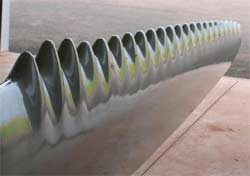The humpback whale flipper, nature's aerodynamic masterpiece, is proving an ideal model for designing better turbine and fan blades.
WhalePower Corp. of Toronto has spent the past year gathering data on how its new bumpy-edged blade design, which mimics the way tubercle-lined humpback flippers move through water, can improve wind turbines and fans.
The results have been impressive, enough to convince Seaforth, Ont.-based Envira-North Systems Ltd. – Canada's largest supplier of industrial ceiling fans – to licence the unique design for a new line of fans. The company plans to launch the fans at the end of April.
"What the tubercles do is make the fan quieter, more efficient, and they're better at pushing down the air," says Monica Bowden, chief executive officer of Envira-North, which claims about 75 per cent of the Canadian market for industrial ventilation fans. In North America it's a $100 million market.
The large fans are about 7 metres in diameter and are typically used in airplane hangars, hockey arenas, distribution facilities, warehouses, shopping malls and dairy farms – any place that requires the even distribution of air. "In tall buildings hot air is at the ceiling and the cold air is at the bottom, so you want to spread it out evenly," says Bowden. She estimates fans incorporating WhalePower's design use 20 per cent less energy and are better at moving the air around.
In a Star story on WhalePower last year, co-founder Stephen Dewar was focused on the potential for using the patented design on wind-turbine blades. "The turbine stuff is going slowly because of the certification and testing that's required," says Dewar, adding it's not from a lack of interest. Nearly a dozen manufacturers of small wind turbines have expressed interest in the design, and two U.S. companies are keen on doing field trials on larger turbines.
The design cycle, while longer and more complicated for wind-turbine blades, is relatively short for products like industrial fans. For example, Dewar says he's already in talks with the largest maker of industrial fans in India.
Why the interest? Marine scientists have long suspected that the long, tubercle-lined flippers of humpbacks might be responsible for their underwater agility, despite being such large creatures.
In one of the first major studies of this effect, U.S. scientists tested a model of a humpback's flipper against a smooth flipper found on other whales. They found 32 per cent less drag and an 8 per cent rise in lift from the bumpy model. The bumps help to channel water flow across the flipper, whereas more of the water that hits a smooth flipper is pushed along the flipper's length to its leading edge, creating more resistance. A Harvard study published last month in the journal Physical Review Letters, and highlighted in the latest Nature, confirmed the aerodynamic effects.
Airflow reacts in a similar way when it moves across a turbine or fan blade. In the case of an Envira-North industrial fan, air is pushed downward more effectively rather than simply pushed outward.
"They've had one running at their factory and the performance has been fabulous," says Dewar. "When it comes down to it, we've got the best blades ever made."
A bold statement, but Dewar hopes the improved performance of Envira-North's fans will draw attention from the wind industry.
Here's an idea: WindShare, the co-operative that oversees the wind turbine at Exhibition Place, is in talks to build another two turbines at the CNE. Why not use the opportunity to demonstrate and study the effectiveness of WhalePower's turbine blade design?
A Toronto demonstration of a Toronto technology that the entire world would be watching closely.

